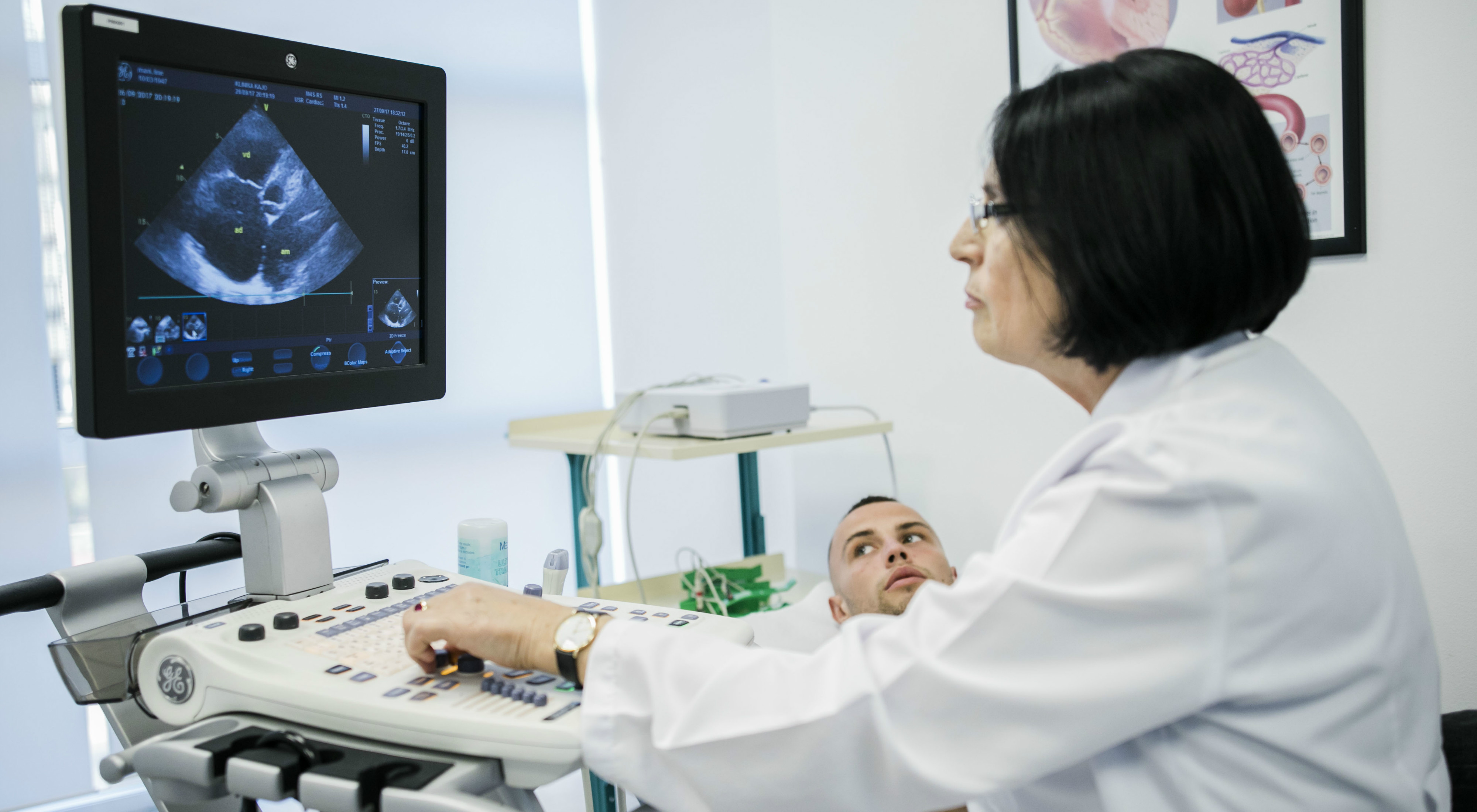
A cardiac ultrasound, also known as echocardiography or simply an echo, is a non-invasive imaging test that uses ultrasound waves to visualize the heart and its blood vessels. This test provides detailed information about the heart’s structures, shape, size, movement, and valve function. Using color Doppler technology, specialists can evaluate how blood flows through the heart, offering a comprehensive assessment of its function.
Echocardiography is divided into two main types:
- Transthoracic Echocardiography (TTE) 🛏️
- Transesophageal Echocardiography (TEE) 🌟
Transthoracic Echocardiography (TTE)
TTE is the most common and non-invasive type of cardiac ultrasound. During this procedure:
- A handheld device (transducer) connected to an ultrasound machine is placed on the chest.
- The transducer sends sound waves through the chest to create images of the heart.
- By moving the transducer to different positions, the cardiologist obtains various views of the heart.
Who Should Get a TTE? 🩺
TTE is recommended for individuals with:
- Heart valve diseases.
- Blood vessel diseases.
- Congenital heart defects.
- Heart muscle diseases (cardiomyopathies).
- Coronary artery diseases, including heart attacks and ischemia.
- Pericardial diseases like acute or chronic pericarditis.
- Heart tumors.
- Heart rhythm disorders (arrhythmias).
- Conduction abnormalities.
- Chronic lung diseases.
- Acute pulmonary embolism (lung blood clots).
- Pulmonary hypertension (high blood pressure in the lungs).
Transesophageal Echocardiography (TEE)
TEE is a more advanced and invasive form of echocardiography. It involves:
- Inserting a flexible, ultrasound-equipped endoscope through the mouth into the esophagus (the tube connecting the throat to the stomach).
- Since the esophagus is close to the heart, TEE provides clearer and more detailed images, especially of small or hard-to-see areas.
Preparation for TEE:
- Avoid eating for 6 hours and drinking fluids for 4 hours before the test. 🚫🍴
- Discuss the procedure with your doctor and complete consent forms. 📝
- A local anesthetic may be used to numb the throat. 💉
- Sedation may be offered to ensure comfort. 😌
When is TEE Recommended? ✅
TEE is ideal when TTE images are unclear or when additional details are needed. It may be recommended for:
- Obstructed TTE views due to:
- Obesity.
- Chronic lung diseases.
- Elevated diaphragm or large skin scars.
- Surgical evaluation for:
- Heart valve diseases.
- Aortic diseases.
- Congenital heart conditions.
- Detecting specific conditions:
- Holes in the heart.
- Artificial valve complications (malfunction or infection).
- Blood clots in the heart (e.g., after a stroke).
- Heart tumors.
- Post-surgery assessments, such as heart valve repairs or replacements.
- Patients with coronary artery diseases, heart attacks, or primary muscle damage.
Advantages of Echocardiography 🌟
- Non-invasive (for TTE): Safe and painless for most patients. 😊
- Detailed insights: Helps assess heart function, valve performance, and blood flow. 📊
- Comprehensive diagnosis: Identifies conditions like heart failure, valve issues, and structural abnormalities. 🫀
Preparing for Echocardiography 🗓️
- For TTE: No special preparation is required.
- For TEE:
- Follow fasting instructions. 🍽️
- Inform your doctor about any existing health conditions or medications.
- Discuss potential risks with your doctor and sign consent forms.
Conclusion 💡
Echocardiography is a vital tool for diagnosing and managing heart conditions. Whether it’s a simple TTE for general evaluation or a more detailed TEE for complex cases, this test allows cardiologists to better understand your heart’s health and determine the best course of treatment.
If you’re scheduled for an echocardiogram:
- Follow the preparation steps provided by your doctor.
- Don’t hesitate to ask questions to ensure you’re comfortable with the process. 💬
Take control of your health—book your appointment for a Cardiac Ultrasound today.
DISCLAIMER:
The information presented on this page has been intentionally condensed and simplified to make it accessible and easier to understand for the general audience. Its purpose is solely to provide basic awareness and education on the topic discussed. It is important to note that this content is not exhaustive and does not replace or serve as a substitute for professional medical advice, diagnosis, or treatment. Readers are strongly advised to seek consultations with qualified healthcare professionals or specialists for accurate assessment, personalized guidance, and appropriate medical care. Relying solely on the information provided here, without professional oversight, may lead to misunderstandings or inadequate treatment.
